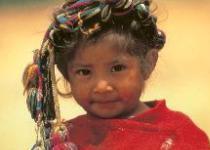
Guatemala Human Rights Commission/USA
.jpg)


.jpg)
Victims Of Stan Need Long-Term Aid: Guatemala Faces Threat Of Hunger
October 15, 2005
By Jill Replogle, Houston Chronicle
CHICACAO, GUATEMALA - Only 30 people, nearly all of them women and children, remain at a church-turned-shelter here in southern Guatemala, putting off the sad task of returning to homes damaged or destroyed in a hurricane. They spend their days hanging around a patio, their nights sleeping on a concrete floor. They are the last of the victims of Hurricane Stan who lodged here. At the storm's height, some 2,000 stayed in eight shelters in this small town nestled in the coastal hills of southern Guatemala.Some of the women say they have nothing left after floods swept away their homes. Others fear that the nearby Nahualate River will jump its banks again and force them to return to the church. All say they need aid, and they seem to be putting off the day they leave. "We've never received any help of any kind from the government," said Vilma Gomez Estrada, a young widow who supports five children by washing clothes for $2 a day. As she talked, she cradled an infant daughter, born just 10 days before the rains forced the family to flee their home. Her husband, she said, died in a car wreck when she was a month pregnant.
Another who has taken up residence at the Protestant church, 52-year old Ana Sac Cox, told how her tin-roof, scrap-wood house had flooded during the storm and several times before. She will probably return to the house, she said, because she has no other option. "I need help," she said.
Nearly two weeks after Hurricane Stan barreled into southern Mexico, bringing torrential rains that flooded rivers and triggered mudslides across Central America, relief workers were still struggling to deliver emergency supplies to isolated communities in Guatemala, the hardest-hit country. But experts warn that long after every hamlet is reached, the storm victims will continue to need assistance. "The people are receiving lots of support right now, but what's worrisome is what will happen over the next two months," said Odet Abascal, who heads Catholic Relief Services' emergency team in Suchitepéquez province, where Chicacao is located.
Though government authorities were still reluctant to give estimates, experts say crops were heavily damaged in Guatemala's highlands and along its Pacific Coast. "The damage is much greater than during Mitch," said Carlos Zuniga, president of the Guatemalan Chamber of Agriculture. Hurricane Mitch destroyed crops and communities throughout Central America in October 1998 and killed an estimated 10,000 people.
In Guatemala, the official death toll from Hurricane Stan stood at 654 on Friday, with 830 people missing. Another 133 people have died in Mexico, El Salvador, Costa Rica, Nicaragua and Honduras. According to Guatemalan government figures, 3.5 million of its citizens have been affected by the storm and nearly 5,000 homes have been destroyed. Many corn, sesame and sorghum crops along the south coast have been destroyed, said Zuniga.
Officials were concerned about the possibility of hunger in this largely agricultural, impoverished nation when the emergency aid stops flowing. "It's going to be at least 10 months before people who lost their crops will be able to start eating them again," said Ian Cherrett, representative of the U.N. Food and Agriculture Organization in Guatemala. He said the probable loss of jobs in coffee plantations and other export crops is also a big concern.
For some of the women at the Chicacao shelter, the time to leave was drawing near. But they had little idea of how they would feed and clothe their families. They hoped the government or private relief agencies would provide the help they needed. But they had no guarantees. "We'll see what God says when we return home," said Gomez Estrada.
Home | Site Map | Contact Us
3321 12th Street NE, Washington, DC 20017
This site is maintained by the Guatemala Human Rights Commission/USA
as a means of informing the general public of the Commission's work
on behalf of the people of Guatemala
